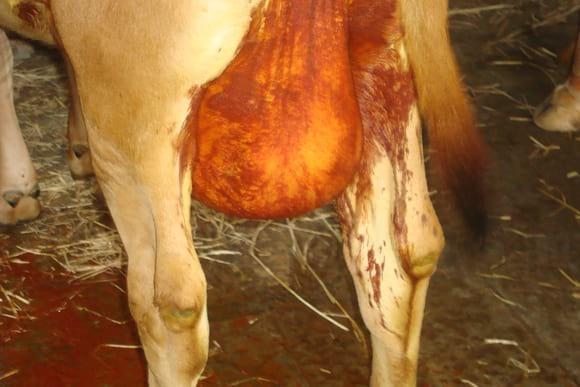Application of herbal formulation for Mastitis
Dear colleagues, Mastitis is a big problem in Dairy cows an goats in our circumstances, specially non clinical type in Cows and gangrene type in goats, but the treatment is mostly money burner and economically difficult for farmers, in my opinion, the prevention is very important. Regarding herbal application, I can say that how much will be the cost and will be available in the market and easy to find. Thanks.
Bovine mastitis is a multifactorial disease . Great number of causes about 50 causes were reported photographically. Treatment of mastitis is very ease within 24 - 36 hours for acute mastitis. For peracute mastitis a period of 6- 9 successive days is required. Herbal formulation for mastitis is not tested and evaluated on clinical mastitis during my field trials on mastitis. The disease requires many drugs and facilities to obtain 100% successus during acute mastitis..Some effective lines for treatment for peracute mastitis are required and lead to a satisfactory results.No preventive methods are applied to prevent mastitis but may be of value to decease some causes of mastitis. Many trials about affections which endanger milk production are prepared photographically with 100% success under fild condition .


North American Renderers Association (NARA)
It is known that citrate level goes down such animal is more prone for mastitis especially at drying off and freshening. At these these two extra supplementation of citrate, trace minerals and vitamins orally will the incidence reduces
Dear Sir,
As you are aware, amongst all diseases in dairy animals, mastitis causes
maximum economic loss. According to one study recently published by the
IIT, Rurkee, of the total economic losses in dairy animals caused by various
infectious diseases, mastitis alone accounts for more than 70% on
per annum.
Most of the time, mastitis is treated with the heavy dose of antibiotics and
production loss on account of mastitis per animal is an expensive
considering direct and indirect losses. Damage caused by the infection to
the udder and the teats is often irreversible and the invaluable animals
have to be culled on this account. Above all, antibiotics used for the
treatment are excreted in milk. Human beings consuming such milk
developing resistance to antibiotics and the problem of antimicrobial
resistance the world over is a very big global issue, which needs immediate
attention of all concerned.
In view of the above, various scientists and agencies, particularly in the
developing countries, have laid more emphasis on the use of Ethno
Veterinary Medicines (EVM), which amongst other ailments have been
found to be very effective in curing mastitis, in a much simpler and
economic way. Moreover, it can prevent permanent damage to the udder
and the teats, on account of fibrosis.
Since there has been increasing emphasis on increasing the productivity of
milch animals, incidences of mastitis may be on the increase in the times to
come. Increased use of EVM based supplements/additives could provide
most amicable solution to this problem.


E.S.E. & INTEC
Prevention is always better than cure: A good milking routine and hygiene will always be the best alternative.

What is herbal formulation? What are its contents and route/s of administration in cows and buffaloe. Treatment of bovine mastitis requires piopnner of veterinary pharmacology of high efficacy and well trained on clinical affections in cows and buffaloe. First of all, not all clinical mastitis causes are known to veterinarians and not mentioned in textbooks. About 50 causes of bovine mastitis were reported photographically under field conditions. Similarly, these causes were reported and treated with 100 % efficacy under field conditions and were documented photographically. Today, I am preparing 2 books containing these items on bovine mastitis and a similar book on teat affections in buffaloes and cows with all causes.
Thank you
Best regards
Prof. Dr. Abd ElSalam ElSawy
Professor of veterinary pharmacology
Fac.Vet,Med, Alexandria University.
Fac.,Vet, Med, Alexandria University , EGYPT.
.. .


North American Renderers Association (NARA)
Dear Sir, Subclinical mastitis if present under field conditions is not reported by me. A decrease in water intake in animal may consider to be subclinical mastitis. This conclusion is based on:
Milk contains 86 % water content. Decrease water intake leads to decrease milk production
Somatic cell count is without value because milk contains up to 1.2 million cells or more cells during clinical mastitis.

Today, there are about 50 causes for clinical mastitis under field conditions. Many veterinarians, researchers and professors are not informed with these causes observed and photographed under field conditions. These causes can be given another names leading to a total number of about 100 causes for clinical mastitis. by all workers with this disease. No herbal formulation can teat all these causes under field conditions.
Thank you
Best regards
Prof.Dr. Abd Elsalam Elsawy.


E.S.E. & INTEC
Hi Everybody, It does not need to be overemphasized that to evolve control measures (cure/ prevention) of any ailment it is prerequisite to find out its basic cause. After knowing the root cause then various possible control measures could be attempted and the most suitable applied to get desirable results. Similarly, we have attempted in mastitis affecting bovines and reached conclusively at the results of its radical cause and control of most economical disease. Our results have been accepted globally and applied successfully in the field at dairy farms.





















